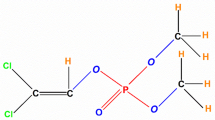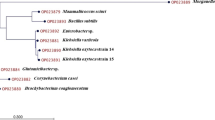Abstract
Green June beetles are a cosmopolitan pest in the United States. Adults are voracious consumers of tree and vine fruit, while their larvae can damage and inadvertently consume root systems, particularly those of grasses, as they move through the soil and forage for detritus. Larvae ingest and process large volumes of soil while in the process of feeding. Due to their intimate contact with the soil, it was hypothesized that soil contaminants that are known animal toxins would perturb the larval and affect their overall health and survival. Studies of this kind are important contributions to the development of new model organisms and our understanding of interactions between the environment, contaminants, gut microbiome, and animal development, health, and survival. It is important to continue to develop relevant model organisms for monitoring toxicity as regulations for working with vertebrates becomes more prohibitive. In this study, the green June beetle larvae were exposed to the explosive RDX (royal demolition explosive; 1,3,5-trinitro-1,3,5,-triazacyclohexane) and phenanthrene throughout their entire soil bound development, starting within the first few days of hatching through to their emergence as adults. The overall findings included that even at high concentrations, RDX and phenanthrene (25 ppm) exerted no significant effect on body weight or survival. Also, there was little apparent effect of RDX and phenanthrene on the bacterial microbiome, and no statistical association with measurable health effects. Nevertheless, the green June beetle is an interesting model for soil toxicity experiments in the future as they are easy to collect, house, and handle.





Similar content being viewed by others
Availability of data and material
Not applicable.
References
Abadin H, Smith C, Ingerman L, Llados FT, Barber LE, Plewak D, Diamond GL (2012) Toxicological profile for RDX. U.S Department of Health and Human Services, Washington, DC
Adamski Z et al (2019) Beetles as model organisms in physiological, biomedical and environmental studies—a review. Front Physiol. https://doi.org/10.3389/fphys.2019.00319
Bingsohn L, Knorr E, Vilcinskas A (2016) The model beetle Tribolium castaneum can be used as an early warning system for transgenerational epigenetic side effects caused by pharmaceuticals. Comp Biochem Phys C 18:57–64. https://doi.org/10.1016/j.cbpc.2016.03.002
Brandon AM et al (2018) Biodegradation of polyethylene and plastic mixtures in mealworms (larvae of Tenebrio molitor) and effects on the Gut Microbiome. Environ Sci Technol 52:6526–6533. https://doi.org/10.1021/acs.est.8b02301
Caporaso JG et al (2010) QIIME allows analysis of high-throughput community sequencing data. Nat Methods. https://doi.org/10.1038/nmeth.f.303
Caporaso JG et al (2011) Global patterns of 16S rRNA diversity at a depth of millions of sequences per sample. PNAS 108:4516–4522
Caporaso JG et al (2012) Ultra-high-throughput microbial community analysis on the Illumina HiSeq and MiSeq platforms. ISME J 6:1621–1624
Cifuentes Y et al (2020) The gut and feed residue microbiota changing during the rearing of Hermetia illucens larvae. Antonie Van Leeuwenhoek 113:1323–1344. https://doi.org/10.1007/s10482-020-01443-0
Crocker FH, Thompson KT, Szecsody JE, Fredrickson HL (2005) Biotic and abiotic degradation of CL-20 and RDX in soils. J Environ Qual 34:2208–2216
Crocker FH, Indest KJ, Fredrickson HL (2006) Biodegradation of the cyclic nitramine explosives RDX, HMX, and CL-20. Appl Microbiol Biotechnol 73:274–290
Crocker FH et al (2015) Evaluation of microbial transport during aerobic bioaugmentation of an RDX-contaminated aquifer. Biodegradation 26:443–451
Drzyzga O, Gorontzy T, Schmidt A, Blotevogel KH (1995) Toxicity of explosives and related compounds to the luminescent bacterium Vibrio fischeri NRRL-B-11177. Arch Environ Contam Toxicol 28:229–235
Howe WL, Campbell WV (1953) A simple method for rearing green June beetle larvae. Agriculture Research Administration, Bureau of Entomology and Plant Quarantine, Washington
Jayamani I, Manzella M, Cupples A (2013) RDX degradation potential in soils previously unexposed to RDX and the identification of RDX-degrading species in one agricultural soil using stable isotope probing. Water. https://doi.org/10.1007/s11270-013-1745-4
Johnson DT, Lewis BA, Bryant RJ, Liyanage R, Lay JO, Pszczolkowski MA (2009) Attractants for the green June Beetle (Coleoptera: Scarabaeidae). J Econ Entomol 102:2224–2232. https://doi.org/10.1603/029.102.0627
Jung CM, Crocker FH, Eberly JO, Indest KJ (2011) Horizontal gene transfer (HGT) as a mechanism of dissemination of RDX-degrading activity among Actinomycete bacteria. J Appl Microbiol 110:1449–1459
Jung CM, Carr M, Blakeney GA, Indest KJ (2019) Enhanced plasmid-mediated bioaugmentation of RDX-contaminated matrices in column studies using donor strain Gordonia sp. KTR9. J Ind Microbiol Biotechnol 46:1273–1281
Just S, Mondot S, Ecker J et al (2018) The gut microbiota drives the impact of bile acids and fat source in diet on mouse metabolism. Microbiome. https://doi.org/10.1186/s40168-018-0510-8
Kibria G (2019) Oil spill and oil pollution- a threat to wildlife, fisheries, seafood security and ecosystems. https://www.researchgate.net/publication/333091943_Oil_Spill_and_Oil_Pollution-_A_Threat_to_Wildlife_Fisheries_Seafood_Security_and_Ecosystems
Kundungal H, Gangarapu M, Sarangapani S, Patchaiyappan A, Devipriya SP (2019) Efficient biodegradation of polyethylene (HDPE) waste by the plastic-eating lesser waxworm (Achroia grisella). Environ Sci Pollut Res Int 26:18509–18519. https://doi.org/10.1007/s11356-019-05038-9
Lu Y-F, Lu M (2015) Remediation of PAH-contaminated soil by the combination of tall fescue, arbuscular mycorrhizal fungus and epigeic earthworms. J Hazard Mater 285:535–541. https://doi.org/10.1016/j.jhazmat.2014.07.021
Lundin JI, Riffell JA, Wasser SK (2015) Polycyclic aromatic hydrocarbons in caribou, moose, and wolf scat samples from three areas of the Alberta oil sands. Environ Pollut 206:527–534. https://doi.org/10.1016/j.envpol.2015.07.035
Michalsen MM et al (2016) Evaluation of biostimulation and bioaugmentation to stimulate hexahydro-1,3,5-trinitro-1,3,5,-triazine degradation in an aerobic groundwater aquifer. Environ Sci Technol 50:7625–7632
Nota B, Bosse M, Ylstra B, van Straalen NM, Roelofs D (2009) Transcriptomics reveals extensive inducible biotransformation in the soil-dwelling invertebrate Folsomia candida exposed to phenanthrene. BMC Genom 10:1–13
Olsen I, Yamazaki K (2019) Can oral bacteria affect the microbiome of the gut? J Oral Micrbiol 2019:1586422
Patel V, Cheturvedula S, Madamwar D (2012) Phenanthrene degradation by Pseudoxanthomonas sp. DMVP2 isolated from hydrocarbon contaminated sediment of Amlakhadi canal, Gujarat, India. J Hazard Mater 201–202:43–51. https://doi.org/10.1016/j.jhazmat.2011.11.002
Przemieniecki SW, Kosewska A, Ciesielski S, Kosewska A (2020) Changes in the gut microbiome and enzymatic profile of Tenebrio molitor larvae biodegrading cellulose, polyethylene and polystyrene waste. Environ Pollut. https://doi.org/10.1016/j.envpol.2019.113265
Shukla SP, Sanders JG, Byrne MJ, Pierce NE (2016) Gut microbiota of dung beetles correspond to dietary specializations of adults and larvae. Mol Ecol 25:6092–6106
Sun K, Liu J, Gao Y, Sheng Y, Kang F, Waigi MG (2015) Inoculating plants with the endophytic bacterium Pseudomonas sp. Ph6-gfp to reduce phenanthrene contamination. Environ Sci Pollut Res 22:19529–19537. https://doi.org/10.1007/s11356-015-5128-9
Suszek-Lopatka B, Maliszewska-Kordybach B, Klimkowicz-Pawlas A, Smreczak B (2016) Influence of temperature on phenanthrene toxicity towards nitrifyingbacteria in three soils with different properties. Environ Pollut 216:911–918
Urbanek AK, Rybak J, Wróbel M, Leluk K, Mirończuk AM (2020) A comprehensive assessment of microbiome diversity in Tenebrio molitor fed with polystyrene waste. Environ Pollut. https://doi.org/10.1016/j.envpol.2020.114281
USEPA USEPA (2003) June bugs invade links; Army wins battle, loses war, retreats, finally wins with new tactics vol EPA/903/F-03/005. Philadelphia, PA
USEPA USEPA (2019) Phenanthrene Fact Sheet
Vishniac HS, Johnson DT (1990) Development of a yeast flora in the adult green June beetle (Cotinis nitida, Scarabaeidae). Mycologia 82:471–479
Yang J, Yang Y, Wu WM, Zhao J, Jiang L (2014) Evidence of polyethylene biodegradation by bacterial strains from the guts of plastic-eating waxworms. Environ Sci Technol 48:13776–13784. https://doi.org/10.1021/es504038a
Yang Y, Yang J, Wu W-M, Zhao J, Song Y, Gao L, Yang R, Jiang L (2015a) Biodegradation and mineralization of polystyrene by plastic-eating mealworms: Part 2. Role of gut microorganisms. Environ Sci Technol 49:13087–13093
Yang Y et al (2015b) Biodegradation and mineralization of polystyrene by plastic-eating mealworms: part 1. Chemical and physical characterization and isotopic tests. Environ Sci Technol 49:12080–12086. https://doi.org/10.1021/acs.est.5b02661
Yang SS et al (2018) Ubiquity of polystyrene digestion and biodegradation within yellow mealworms, larvae of Tenebrio molitor Linnaeus (Coleoptera: Tenebrionidae). Chemosphere 212:262–271. https://doi.org/10.1016/j.chemosphere.2018.08.078
Yuan M (2010) The preparation and analysis of polycyclic aromatic hydrocarbons in meat by GC/MS vol http://www.perkinelmer.com/PDFs/downloads/APP_PAHinMeatbyGCMS.pdf. Shelton, CT
Acknowledgements
This research was funded through the U.S. Army Corps of Engineers’ Environmental Quality Program. Views, opinions and/or findings contained herein are those of the authors and should not be construed as an Official Department of the Army position or decision unless so designated by other official documentation. The authors would like to thank Donn T. Johnson and Lizbeth R. Herrera (University of Arkansas) for trapping adult beetles for the initiation of this study and for scientific advice. The authors would also like to thank Richard Lance, Denise Lindsay, Kayla Clark, and Karl Indest for reviewing the manuscript and providing scientific advice and field/laboratory assistance.
Funding
This research was funded through the U.S. Army Corps of Engineers’ Environmental Quality Program. Views, opinions, and/or findings contained herein are those of the authors and should not be construed as an Official Department of the Army position or decision unless so designated by other official documentation.
Author information
Authors and Affiliations
Contributions
Not applicable.
Corresponding author
Ethics declarations
Conflicts of interest
The authors declare that they have no conflict of interest.
Ethics approval
Not applicable.
Consent to participate
Not applicable.
Consent for publication
Not applicable.
Code availability
Not applicable.
Additional information
Editorial responsibility: Jing Chen.
Rights and permissions
About this article
Cite this article
Jung, C.M., Carr, M., Fleischman, E. et al. Response of the green June beetle and its gut microbiome to RDX and phenanthrene. Int. J. Environ. Sci. Technol. 18, 1785–1792 (2021). https://doi.org/10.1007/s13762-020-02960-1
Received:
Revised:
Accepted:
Published:
Issue Date:
DOI: https://doi.org/10.1007/s13762-020-02960-1




